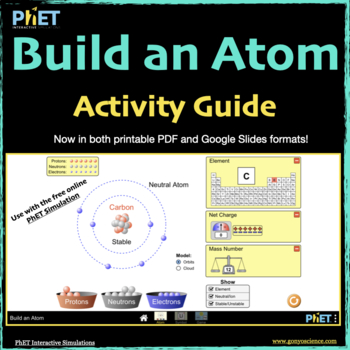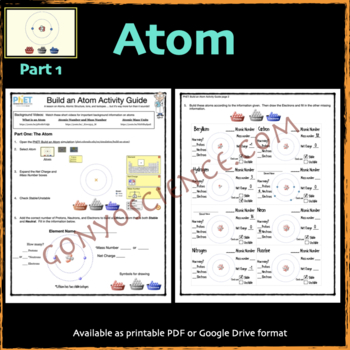PhET Build an Atom activity guide
- Zip
- Google Apps™
- Easel Activity

What educators are saying
Also included in
- Now includes printable PDF, Google Slides, and TPT Easel versions!The PhET Chemistry Activity Guides are used along with the free *Next Generation PhET Simulations. All activity guides are in PDF and Google Slides formats and include an answer key and a Getting Started Guide for teachers.Your studenPrice $28.00Original Price $35.00Save $7.00
Description
Now includes both printable PDF and Google Slides versions!
The PhET:Building an Atom Activity Guide is used along with the free *Next Generation PhET Simulation on Building an Atom. Students will experiment with adding protons, neutrons, and electrons to an atomic model to create atoms of different elements.
Your students will hit the ground running without the need for a lengthy introduction from you. Just print the activity guide or share from your Google Drive. Students can watch the intro videos and away they go. The best part is that they don’t even know they are learning, they just think they are having fun!
The activity guide takes students through all 3 parts of the simulation: The Atom, Symbols, and The Game. The final section of the lesson, Understanding the Atom, challenges students to expand on what they have learned. Students will learn:
- to recognize the basic structure of an atom
- how protons and neutrons affect the atomic mass of an atom
- how electrons affect the charge of an ion
- how protons determine the name of the element
- to identify elements from their number of protons, neutrons, and electrons
- to calculate charge and mass number
- to interpret atomic symbols
- the concepts of atomic structure, atomic mass, relative atomic mass, ions, stable and unstable isotopes, and both orbital and electron cloud models of the atom.
In part 3, The Game, students are given a chance to improve their understanding and to demonstrate what they have learned through 4 challenging and fun games. Finally, part 4 will challenge students to do research to expand on what they have learned.
The activity guide begins with a short introductory video to give students background information and includes both PDF and Google Slides versions for printing worksheets or sharing via Google Drive or Google Classroom. This lesson is perfect for face to face, hybrid, or remote learning!
This product includes the Activity Guide (pdf), Activity Guide (Google Slides), Answer Key (pdf), and a Getting Started Guide for teachers.
*PhET simulations are fun, interactive, research-based simulations of physical phenomena. As students interact with the simulation, they get immediate feedback about the affects of the changes they made. All PhET simulations are freely available from the PhET website (phet.colorado.edu) and are easy to use and incorporate into the classroom. The new Next Generation sims utilize HTML 5 which allows them to run in any modern web browser on most devices including Chromebooks and tablets like the iPad! Learn more about using PhET Simulations with your students.
Bundle and save!







